Third Grade Science Station Units
As an elementary teacher, science and social studies were the subjects I struggled to teach well. I put so much time and effort into making sure my students were receiving differentiated reading and math instruction that there was very little energy left to create materials for science and social studies with the same rigor. We also had a lack of materials for those subject areas, so they took more work plan. Can you relate?

This past year, a friend and I created these Third Grade Science Stations (link to TpT) that cover all the Next Generation Science Standards for Third Grade. Here are the domains and standards for each set of stations as well as links to each set.
Third Grade Science Station Topics
Physical Science
✔ Force & Motion – NGSS 3-PS2.A
✔ Static Electricity & Magnetism – NGSS 3-PS2.B
Life Science
✔ Life Cycles: Plants and Animals – NGSS 3-LS1.B
✔ Ecosystems: Animal Group Behavior & Interactions – NGSS 3-LS2.D
✔ Inheritance and Variation of Traits – NGSS 3-LS3.A and 3-LS3.B
✔ Ecosystems and Biodiversity – NGSS 3-LS2.C and 3-LS4.D
✔ Plants & Animals Long Gone – NGSS 3-LS4.A
✔ Natural Selection & Adaptations – NGSS 3-LS4.A
Earth Science
✔ Weather & Climate – NGSS 3-ESS2.D & NGSS 3-ESS3.B
Each set of science stations is built the same way with 8 separate science stations that approach the standard and topic slightly differently and require students to do a different kind of work.
Science Stations
► Watch a Video – Students watch a video about the concept and answer questions.
► Play a Video Game – Student interact with a video game about the concept. They then respond to questions about their experience.
► Investigate – Students investigate the concept and answer questions.
► Diagram – Students diagram about the concept and answer questions about it.
► Read a Passage – Students read a passage and answer questions about the concept.
► Model – Students model the concept and answer questions about their models.
► Explore – Students explore the concept and questions about it.
► Sort – Students do a sort about the concept and explain their reasoning.
Some of the stations include more than one activity or extensions. These are great for early finishers or students who want to dig a little deeper into the concept.
Differentiated Responses
Each station includes four different ways to respond to the experience at the station:
- short answer questions
- fill-in the blank questions
- task cards with short answers
- task cards with multiple choice
All the variations are similar to one another, but require a different level of independence. The fill-in-the-blank is the easiest and perfect for your students who struggle with reading, especially if you provide them with a word bank. The short answer is the most difficult as it requires students to construct their own responses without much support.
Choose the format that best fits your classroom and students. Students are also encouraged to use their science journal via the task cards. Answer keys are included for all of the differentiated response formats.
Some activities also include a worksheet in addition to the differentiated responses. This worksheet is the “work” of the station. The differentiated responses require students to think broadly about the topic and concept.
In the photos below you’ll see examples of the four types of differentiated responses.
An In-Depth Look at the Third Grade Science Stations
Below is information and details about each Science Station. The examples below are from the Ecosystems and Biodiversity Science Stations which address NGSS 3-LS2.C and 3-LS4.D and includes concepts such food chains, food webs, traits of organism change due to environmental changes, how animals affect their environment, invasive species, and biomes.
Vocabulary Cards

Included are two types of vocabulary cards. One set is three-part vocabulary cards that can become a separate matching station, if you need 9 stations or if you have earlier finishers at some of the other stations.

The other set of vocabulary cards are just the word and definition. These are great for a word wall or pocket chart that you display for the unit.
Watch a Video
In this station, students use a computer to watch a video about the science topic. Some videos need a computer and some videos can be accessed using a tablet or other device. Those that can be accessed via device also include a QR Code.
After watching the video, students answer questions about what they watched on the worksheets or in their science journals. The informative videos that we have chosen for these science stations go in-depth about the topic and concepts but are also accessible to a wide range of student abilities.

For most science stations, we have provided two different videos to watch. You can let students choose which video to watch, assign one of the videos or have one video be an extra science station, if you need more options. Each video comes with it’s own set of differentiated responses.
Play a Video Game
Do your students love playing video games as much as mine do? Although I can’t promise that these videos will be as engaging as some games played at home, they will be educational!
In this station, students play a video game on the computer. The video game or the direction worksheet guides students through the game and has them respond to prompts along the way. At the conclusion of the game are differentiated reflection questions about the concepts learned in the game.

Investigate THe Colors of Leaves
The investigations vary across science stations and topics. Generally the investigation includes a short text passage, hands-on activity, a worksheet to respond to the hands-on experience and differentiated questions.
In this specific investigation, students are exploring why certain colors of bugs get eaten more often than other colors of bugs. Not photographed are the differentiated student responses.

Diagram Otter Food Chain
In the Diagram station, students create a diagram about the concept. There is often a reading passage as well as a worksheet to go with the activity.
In the Ecosystems and Biodiversity set of stations, students read about the Otter Food Chain, diagram it, then fill out a graphic organizer outlining the cause and effect relationship of each organism in the food chain. In addition to the worksheet are a set of differentiated responses.

Read a Passage about Beavers
In this section, students read a passage, usually 1-2 pages in length, about a topic related to the concept. The passages has subheads and most passages have pictures to accompany them. After reading the passage, students answer a set of the differentiated response questions. Pictured below is the full-in-the-blank response.

Model Deforestation
Model is another station that generally has a hands-on component to it, like Investigate and Explore. In Model, students either create or analyze a model related to the topic. Often there is a related text with the activity.
In this example, students read a couple paragraphs about deforestation and then identify which sentences describe the pictures that illustrate a rainforest, deforestation, and conservation. In addition to the activity are differentiated response questions in the formats above.

Explore Invasive Species
The explore station asks students to look at the concept and topic at a deeper level by exploring one aspect of it. The explore station will either have a hands-on activity or a reading passage with a worksheet that has students draw conclusions and explain their thinking. Like all the other stations, there are four ways to respond to the exploration.
In this particular station, students explore 5 different invasive species and explain what happens to the environment as a result of their introduction. Pictured is the worksheet as well as the differentiated responses.

Sort Biomes
The sort station has students sort organisms or something related to the topic. The sort is often accompanied by a reading passage and may include additional reading on each sort card. The sort is available as a cut and paste activity like you see below as well as a full-color card sort.
In the picture, students sort organisms into different biomes using the picture and details in the bullet points. Not pictured are the differentiated student responses.

Here is a video that highlights all of our third grade sorting activities:
[adthrive-in-post-video-player video-id=”B3eTLJUc” upload-date=”2023-11-18T05:23:18.000Z” name=”Third Grade Science Sorts” description=”” player-type=”default” override-embed=”default”]
What Others Are Saying
Below is feedback from classroom teachers on Teachers Pay Teachers:
Jamie said:
WOW!!! This is an amazing resource that is really helping me to plan according to NGSS standards. My third graders love the variety of activities that really help them understand scientific topics at a deep level. I love how easy these stations are to implement and plan! Thank you for an amazing resource.
Sara said:
This bundle is going to make SUCH a difference in my classroom this year!! We have adopted the NGSS, so this pack is going to help me plan tremendously. The activities included are going to help my students understand what the standards are asking of them in unique and fun ways. The different stations are going to encourage all kinds of levels of thinking, which is going to be great to sit back and watch. Thank you for putting such effort into this set of resources. The depth of each resource is backed by so much research on your part, so I cannot wait to see my students flourish and grow at every stage of the work we complete! Thank you, thank you, thank you.
Laura said:
With new NGSS standards implemented this year, and limited resources, this was perfect!! The activities, information, and organization was very clear and engaging for students. This covers all that I need to teach science to 3rd grade!!
Teresa said:
I love the higher level thinking strategies that went into this product. We are using the Next Generation Standards and this is the perfect mix for my students. Higher level thinking, application of the information in different learning modalities. This is going to help my kids a great deal. I have never been disappointed with any materials that I have purchased through you and I greatly appreciate that my teacher dollars are going to something meaningful and helpful to my kids. Thanks!
How to Purchase The Third Grade Science Stations
You can purchase the Third Grade Science Stations on my web site or on Teachers Pay Teachers. There is a grade-level bundle, sets by standard, and each station is available individually as well.
Here are links to each set:
Physical Science
✔ Force & Motion – NGSS 3-PS2.A
✔ Static Electricity & Magnetism – NGSS 3-PS2.B
Life Science
✔ Life Cycles: Plants and Animals – NGSS 3-LS1.B
✔ Ecosystems: Animal Group Behavior & Interactions – NGSS 3-LS2.D
✔ Inheritance and Variation of Traits – NGSS 3-LS3.A and 3-LS3.B
✔ Ecosystems and Biodiversity – NGSS 3-LS2.C and 3-LS4.D
✔ Plants & Animals Long Gone – NGSS 3-LS4.A
✔ Natural Selection & Adaptations – NGSS 3-LS4.A
Earth Science
✔ Weather & Climate – NGSS 3-ESS2.D & NGSS 3-ESS3.B
Would you like a Free Science Station?
I have a set of free science stations for 2nd, 3rd, and 4th. Click here or the image below to access them.



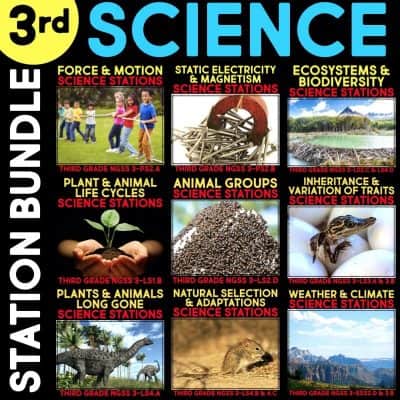
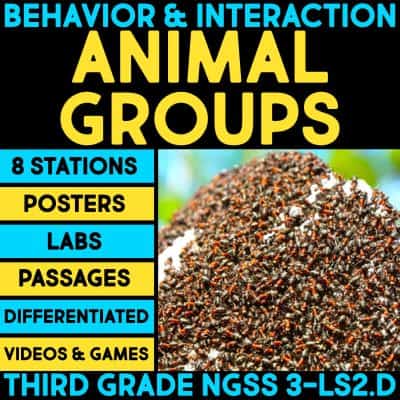
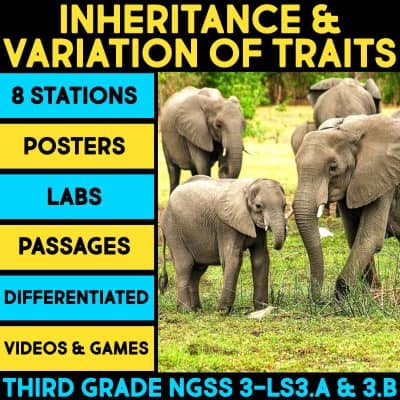
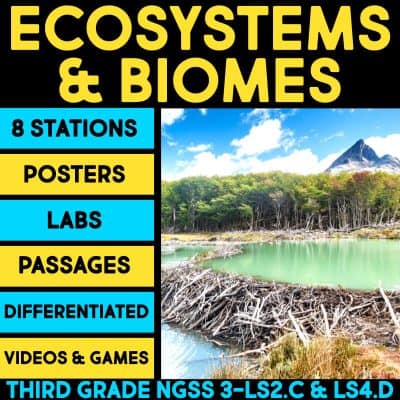
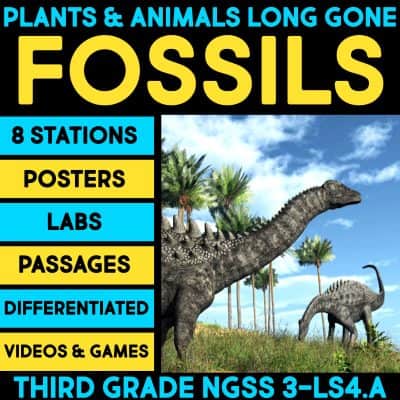
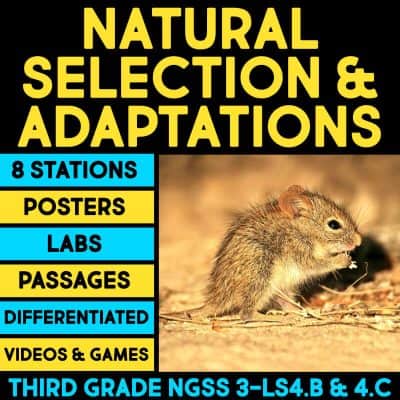

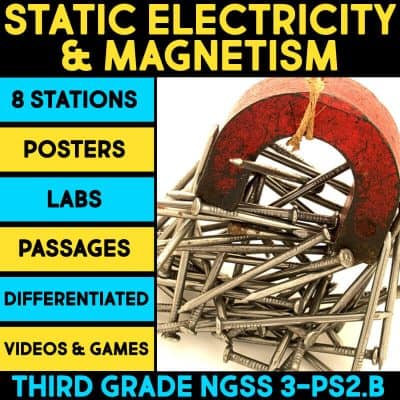
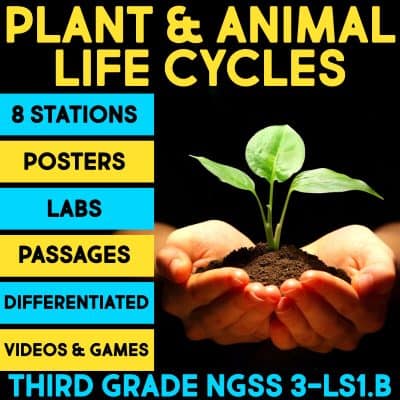

Do you have anything for 4th or 5th grade?
We’re in the process of working on the 4th grade ones and will do the 5th grade after those are completed.
I am a long term sub until March in a 3rd grade class. I have only taught 1st and kindergarten. Love you site. Want to follow you! love your site!!!!!!
Do you have anything for first grade?
No, I’m sorry I don’t have science stations for first grade.
I own one and love it! I have several others on the wishlist for the next sale!
I would love to see some for Matter: Properties and Change, Energy: Conservation and Transfer. Earth in the Universe, Earth’s landforms, and Body Systems.
This is amazing stuff! I have been changed to be strictly the Science and Social Studies teacher for the entire 3rd grade (we level our kids). So I will have 3 blocks of classes, leveled as High, Medium, & Low. Do you have any resources for social studies stations? I am struggling to find resources for both subjects!
I do not have resources for third grade social studies. In our state, it’s mostly about local history, so it’s not something I’d create for TpT.
Hello, this is awesome and I was just wondering if you ever put anything together for 4th and 5th grade. I teach a special ed students so im always looking for fun stuff. Thanks.
Fourth grade science stations are here: https://www.teacherspayteachers.com/Store/What-I-Have-Learned/Category/Science-Stations-4th-Grade-278287 . We do not have fifth grade stations yet.
I love your science stations. I. Excited about setting it up in my room. How do you set it up in your room foe student access? Do you have pictures?.
Thanks! They’re so fun to use! I need to do a blog post on how I set up the science stations, but the gist of it is that I use 8 baskets that hold letter-size paper. They hold the materials for the station. I have table groups in my classroom along with two horseshoe tables, a computer area, and floor space. I distribute the baskets to the tables. Students start at one station and rotate through all the stations. There’s a checklist in the product that I use. I list student names down the side and keep track of which stations that group has visited each day. With 24 students, I have about 3 three students per station. We do 1-2 stations a day, depending on the time, so each set lasts 2-3 weeks. We do the rotations 2-3 times a week.
Do you any idea when 5th grade stations will be done?
No. We don’t have a timeline for those yet. Our focus right now is the 5E Units for 4th and 2nd. We will then circle back to 5th grade science units.